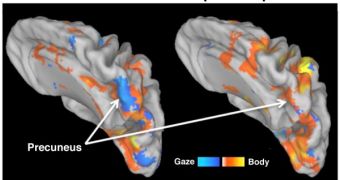A new study conducted at UC Santa Barbara concluded that the brain has several maps in a region called the precuneus, inside the parietal lobe, and these maps are what allow people to reach for different things and plan different movements.
The two scientists examined the brains of 18 individuals who made 400 different arm reaches, while laying in an MRI scanner, and found that the brain activity differs depending on the type of reaching behavior – towards one's own body or aimed at visual targets.
Scott T. Grafton, professor of psychology said that they were “interested in movement planning and movement control.
“We're looking at goal-directed behaviors, when we reach to grasp objects — visually defined objects in our environment.
“This forms the basis of our interactions with the world.”
The widely accepted opinion is that all reaching movements are planned using a visual map but these new “findings suggest otherwise,” according to Pierre-Michel Bernier, first author and postdoctoral fellow.
“We found that when a target is visual, the posterior parietal cortex is activated, coding the movement using a visual map.
“However, if a movement is performed in darkness and the target is non-visual, the same brain region will use a fundamentally different map to plan the movement; it will use a body map.”
As said before, these maps are inside the parietal lobe, so the researchers measured the "Blood Oxygen Level Dependent Signal," or BOLD signal, when they analyzed the MRI brain images.
BOLD allows the measuring of the brain activity at a millimeter scale.
The researchers also used the 'repetition suppression' method, which identifies where the maps are located in the human brain.
This methodology is based on the fact that once a brain region is involved in two similar activities in a row, the second time around it will be less active.
“We are a leader in the use of repetition suppression,” Grafton said.
The two scientists managed to prove that the brain uses body maps instead of visual maps by isolating the part of the brain where the responses were less active with repeated, similar arm reaches.
Grafton said that these “results have two important applications.
“One is robotics; the other is in the area of machine-brain interface.
“For example, in developing machines to help paraplegics; a critical issue is to understand how movement-related information is represented in the brain if we're to decode it.”
He said that “the brain is trying to make a map of the world.
“One map is what you see, which is provided by the visual system.
“The other map is where the body is in space.
“This map is based on proprioception — the sense of limb position — which is derived from receptors in the skin, muscles and joints.
“These maps are very different.
“How do you connect them?
“Either the visual map or the body map may be fixed, or neither may be fixed.”
Grafton is a leading expert in brain imaging, and he directs the UC Santa Barbara Brain Imaging Center where the university's MRI scanner is located.
This discovery is reported in the journal Neuron.

 14 DAY TRIAL //
14 DAY TRIAL //